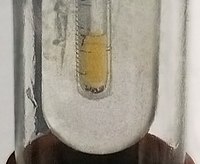
Photo from wikipedia
Non-ablative and ablative fractional erbium lasers are among the most frequently used resources in dermatology for facial rejuvenation and for treating dermatological disorders. This type of erbium laser can be… Click to show full abstract
Non-ablative and ablative fractional erbium lasers are among the most frequently used resources in dermatology for facial rejuvenation and for treating dermatological disorders. This type of erbium laser can be found at wavelengths of 1540 or 1550 nm, which are classified as non-ablative erbium glass, and at 2940 nm, classified as ablative erbium YAG. Despite the reports of their clinical benefits, few scientific studies have demonstrated the efficacy and safety of these lasers in the short or long term. In order to substantiate the effects, benefits, and safety of applying the erbium glass and erbium YAG lasers, a systematic review was carried out from August to December 2019 about studies published in the last 20 years. Randomized clinical trials in humans were considered that evaluated the efficacy, safety, and benefits of applying the fractional lasers erbium glass and erbium YAG to facial rejuvenation, skin spots, and atrophic acne scars. A total of 338 articles were identified; 76 articles remained after their titles and abstracts were read, and 42 articles were selected after removing the duplicates. After the articles were read in full, 17 of these articles were included in the systematic review (453 patients). The erbium glass and erbium YAG lasers seem promising in the short term, with minimal adverse effects; however, the long-term efficacy and safety still present limitations. Consequently, future research is needed, with better methodological standardization and a follow-up with a longer evaluation period for possible permanent adverse effects to determine the standardization and safety of therapy with erbium glass and erbium YAG lasers.
Journal Title: Lasers in Medical Science
Year Published: 2020
Link to full text (if available)
Share on Social Media: Sign Up to like & get
recommendations!